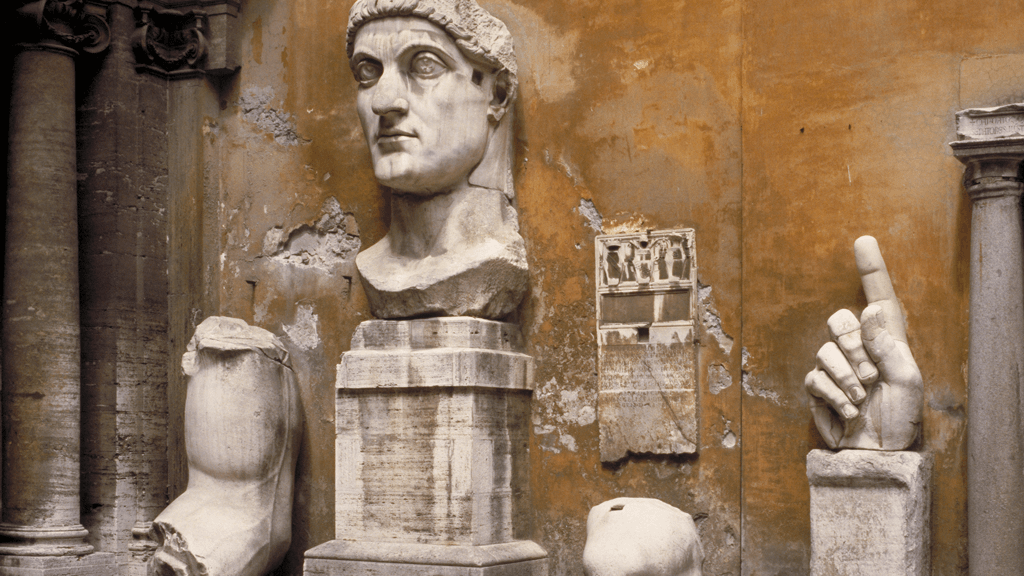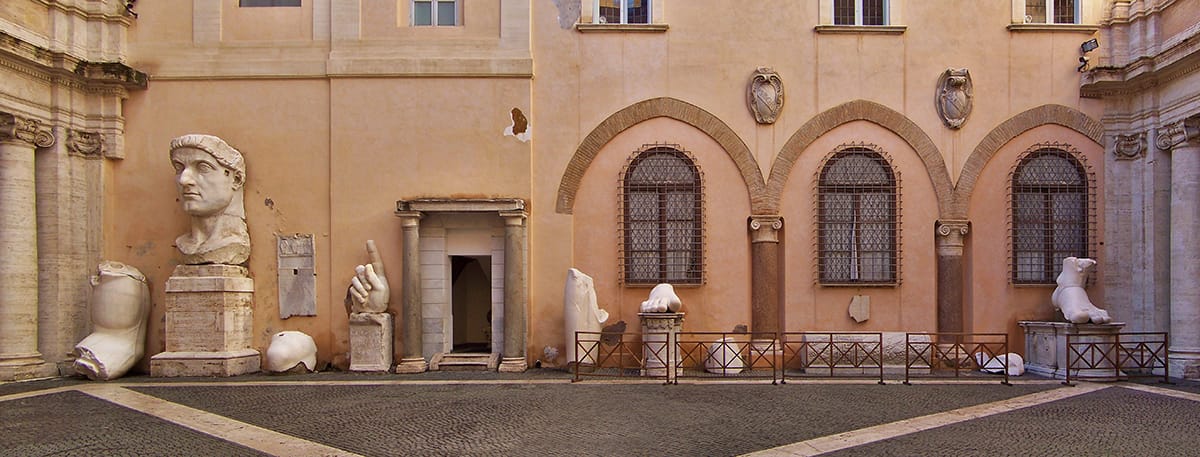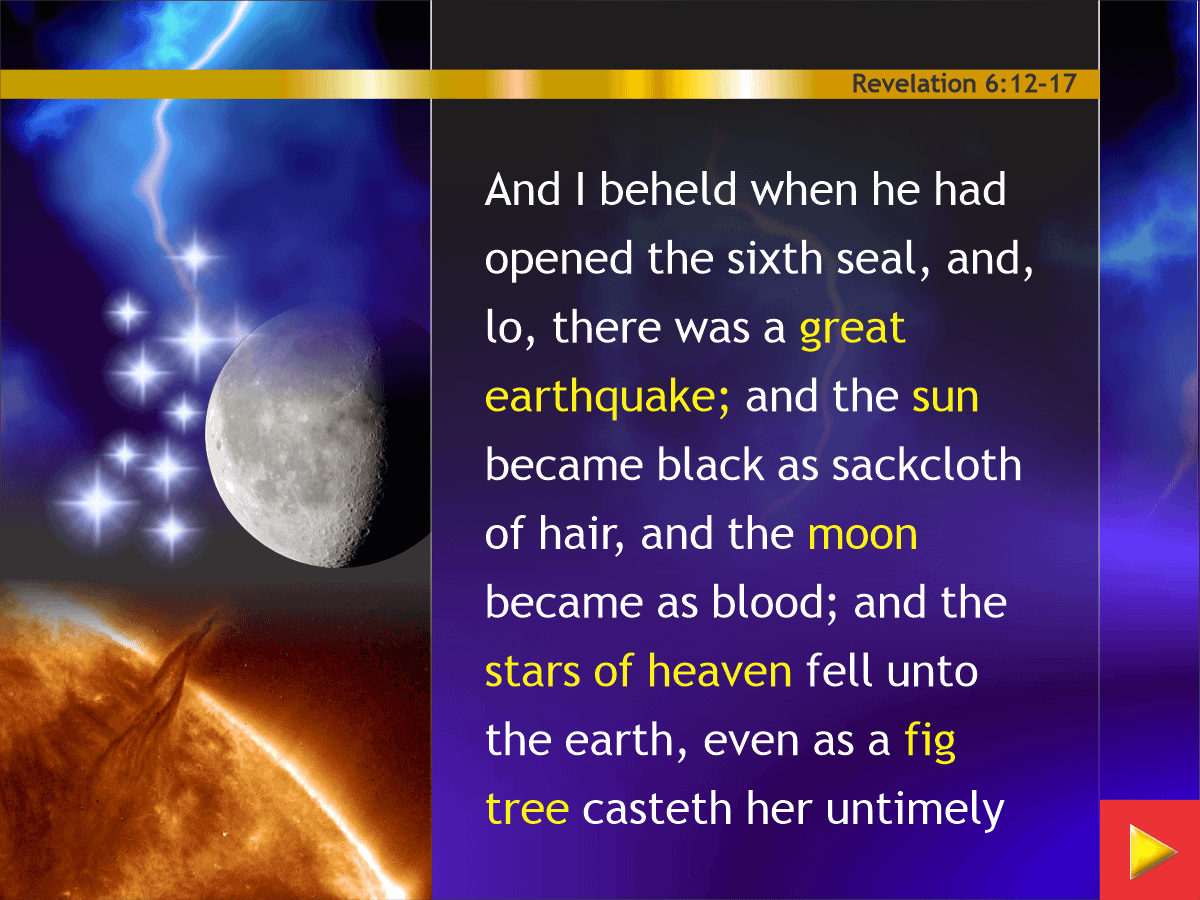Prophecy
Revelation
The Sixth Seal – Part One
The fall of paganism
Pieces of the Colossus of Constantine – originally a gigantic, enthroned statue of Constantine the Great. The head itself is about 2.5 metres high.

The great earthquake and shaking of the heavens
And I beheld when he had opened the sixth seal, and, lo, there was a great earthquake; and the sun became black as sackcloth of hair, and the moon became as blood; And the stars of heaven fell unto the earth, even as a fig tree casteth her untimely figs, when she is shaken of a mighty wind.…
Immediately after Diocletian’s time, a great upheaval in the empire took place when Constantine became emperor. Aligning himself with Christianity, Constantine fought against his pagan rivals to the throne. He established Christianity as the state religion and during the next century his successors generally followed his lead. The worship of the old Roman and Greek gods virtually disappeared and the empire was nominally Christianised. Constantine also removed the seat of the emperors from Rome and established a new seat in Constantinople.

The first five seals have outlined the height of Imperial Rome's power, the subsequent causes of its decline, and its final desperate attack on Christianity. These eras in history began a year or two after John was shown those things “which must shortly come to pass”.
The next vision is extended in length, but its primary subject is that of a great convulsion in the earth (the land of the Empire) and the heavens (the ruling powers and influence). The period immediately following the persecution of the Christians, is one of the great eras of history, and witnesses the overturning of the entire system of paganism throughout the empire. It is the era that Rome became “Christian”.
This primary vision of the Sixth Seal needs care in interpretation. It is important to remember that we are dealing with symbols, as we have been in the other visions, not literal convulsions of the earth and heavens. Care is also needed because this vision is easily mistaken for the return of Jesus Christ. While it certainly, and no doubt intentionally, has an echo and foretaste of that event, a comparison of other prophecies that have similar language and their own history will show that this vision can have a completely separate historical fulfilment.
To demonstrate this we will note the phrases used here and compare them with the other scripture prophecies to follow.

In the next four passages of scripture, we will see examples of the same imagery and phrasing applied to historical events and overthrows of the past. The symbols were clearly symbols and did not all take place literally. They also echo the language used of the Lord’s return even though they had their own historical fulfilments at the time. Understanding this will help us to understand the local application of the Sixth Seal vision to the history of the Roman Empire at the time immediately after Diocletian, while recognising that the language foreshadows the similar convulsions in the order of things when Christ returns. Great revolutions and overthrows are naturally described in similar language to the greatest revolution and overthrow of all.
In this passage the King of Egypt and Egypt’s downfall is prophesied in terms of the “ruling” heavenly bodies being darkened and authority being put out.








Again, though there is a foreshadowing of the future in these prophecies, the mention of the Medes here makes clear the application in a local historical sense. And history confirms the truth of it.
(There is a principle in music called harmonics that seems to me to echo quite well how one prophecy can strike two “notes” at, in a sense, different frequencies – just as the same length of tubing in a trumpet can produce more than one note at different frequencies. The notes however are strictly related to each other and the particular length of the tube. Each length of tube can only produce a certain limited set of related notes. It is likely that prophecies that have more than one fulfilment work the same way – they must be related, not pick-and-choose-for-convenience fulfilments. The fact that Babylon was the head of Nebuchadnezzar’s image, and the head represents and controls the whole body, including the legs and feet of Rome, is a good reason for the prophecies of Babylon in Jeremiah to be related to spiritual Babylon or Rome in Revelation. In the same way, the vision of the Sixth Seal deals with the revolution caused by the “Christianising” of the then world – a revolution that reflects the change in the world at the return of Jesus Christ.)

With the coming to power of Constantine, the Empire underwent a major revolution. Constantine became a “nominal” Christian and in a military struggle which developed into a war between pagan and “Christian” armies, took control. The tables were turned on the pagans who had persecuted the Christians. Christianity went from being persecuted almost to extinction, to ultimately becoming the official religion of the Empire. The entire Roman/Greek system of pagan worship was overturned in the era that followed as a series of nominally Christian emperors continued until the partition of the empire into East and West. The brief exception to this in the time of Julian, who tried to reinstate the pagan gods, was not able to change the Empire’s direction. By the time of Theodosius, and through his efforts also, the old Roman pagan worship passed completely away.
Constantine also removed the seat of power from Rome to a new city in the East which he built and called Constantinople, opening the way in the future for the Papacy in Rome to rise to power. (This was part of the fulfilment of the “let” or hindrance that the apostle Paul said was to be taken out of the way). While the persecution in Diocletian’s time had no doubt weeded out the insincere, the acceptance of Christianity in Constantine’s era caused many to join themselves to the Christians merely for the sake of political expediency. This period, as a result, saw great corruption creep into the church, out of which grew the many false and pagan doctrines of what became the “Catholic Church”.




The war became a battle for the dominance of either paganism or Christianity. The historian notes the fear and dismay of those who fought against this “Jesus Christ” they had persecuted. As the prophecy said, “hide us from the face of him that sitteth on the throne, and from the wrath of the Lamb: For the great day of his wrath is come; and who shall be able to stand?”
The coins here show the head of Constantine on the front, and on the back, a dragon, or serpent, representing pagan Rome, speared by Constantine's military standard, the Labarum, with the Chi-Rho on top of it. The Chi Rho was formed of the first two Greek letters of the word “Christ” (looking like our X and P).

More coins of Constantine and Magnetius (a later “Christian” emperor of the era). Note that on either side of the Chi Rho (XP) are the Greek letters Alpha and Omega, signifying Christ as he names himself in the very book of Revelation. The context of this title later in Revelation 22 and its appearance here at this time in history shows that the prophecy indeed has a foreshadowing of Christ’s return and the upheaval he will bring. It is, after all, the Roman kingdom ultimately, that his Kingdom of Stone will eternally replace.
Revelation 22:12-13
12 And, behold, I come quickly; and my reward is with me, to give every man according as his work shall be.
13 I am Alpha and Omega, the beginning and the end, the first and the last.














